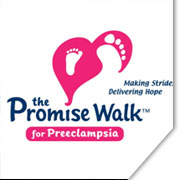I remember the first time I heard of preeclampsia . Despite the fact that I’ve worked my whole adult career in hospitals and health care, I didn’t first learn about preeclampsia on the job. In truth, I read about it years ago – and rather graphically – in the John Irving novel, The Cider House Rules. (FYI, readers: you will not find a scene about preeclampsia in the movie version starring Toby Maguire and Charlize Theron. That, along with much more, was edited out of the book for the screenplay.)
Preeclampsia is a form of high blood pressure brought on by pregnancy and occurs after the 20th week of pregnancy. It is also known as toxemia. In some women, a more severe form of the illness, eclampsia  develop, causing seizures or convulsions. It’s a leading cause of premature births, and the only sure treatment is delivery of the baby. If that doesn’t happen, the condition can take the life of both mother and her unborn child.
develop, causing seizures or convulsions. It’s a leading cause of premature births, and the only sure treatment is delivery of the baby. If that doesn’t happen, the condition can take the life of both mother and her unborn child.
That’s what the pregnant woman at the orphanage giving birth in The Cider House Rules had. In the story, she was in labor, flailing and jack-knifing on the table in the midst of a full-blown seizure. It freaked me out. And I remember thinking after the lead character Homer saves the day – and thus the eclampsic woman’s life, “Geez…bad enough the poor woman had to sneak off to give birth to an unwanted child whom she was going to abandon at the orphanage. Did she really need to have such an emotionally gut-wrenching experience made all the worse by this, this “preeclampsia?” At the time, it seemed like “down-on-one’s-luck overkill” for a lone character. I would come to learn later, though, that Irving didn’t really add any unnecessary drama to the story. Pre-eclampsia was and reemains actually quite common with consequences quite dramatic. No creative literary license was taken. Irving was apparently right on the money with the realism.
I didn’t hear a thing about preeclampsia until almost ten years later – and at that time is was through work, when I began working with obstetricians. But how come I hadn’t heard about preeclampsia for a whole decade, a time when I’d been surrounded by pregnant relatives, friends and co-workers? I remember some of them having to have emergency c-sections because of high blood pressure…but was this preeclampsia?
Why wasn’t anyone talking about this?
One in 12 pregnant women suffers from this life-threatening disorder – it’s much more common than, for instance, gestational diabetes, or the rare birth defects that many pregnant woman fear. Why isn’t it being plastered on the side of SEPTA busses that any woman can develop this sudden, life-threatening onset of high blood pressure after 20 weeks of pregnancy? Though it’s a leading cause of preterm births, there is no known prevention for pre-eclampsia. And even if the baby is born healthy, the condition can have a lasting impact on mom, increasing a woman’s risk of heart disease after her pregnancy, and even causing life-long heart disease.
Recently, to help educate and inform women about this very dangerous condition, Nazanin Moghbeli, MD, MPH, director of the Women’s Cardiovascular Center at Pennsylvania Hospital and obstetrician and gynecologist Renee T. Anderson, DO, also from Pennsylvania Hospital, hosted an free public event to educate women about this condition, called “Managing Preeclampsia and High Blood Pressure During Pregnancy: How to Minimize Risk for Heart Disease.” But turnout was poor, making me wonder: What’s the best way to get this important message out to women?
So again I ask, why? For something that affects one in every 12 pregnant women and can have such long lasting and lifethreatening effects, why don’t more women know about preeclampsia?
For the most part, pregnancy is still one of the most desirable and happiest situations a woman may experience in life. Women want to focus on ultrasounds, picking out baby names, and painting nurseries. They want to think about the joyous aspects of having a baby. But women of all ages really do need to care and worry about pre-eclampsia. Still wondering why?
- Because the condition is more likely to show up during first pregnancies, multiple gestations, teen pregnancies, and those of women over 35.
- Because it causes a woman’s blood vessels to constrict, and reduces the amount of oxygen and nutrients delivered to the baby, leading to low birth weight.
- Because if left untreated, it can also cause liver, lungs, and kidney failure.
- Because women with chronic high blood pressure, a kidney disorder, or diabetes, is already at a higher risk for preeclampsia.
- Because a woman who has had preeclampsia before has aa 25 to 50 percent of developing it in a future pregnancy, as well.
- Because if a woman’s mother had pre-eclampsia, she is also automatically at increased risk.
- Because, despite intensive research, no one knows exactly what causes preeclampsia and humans are the only species that are known to get this disease, so animal research is not helping.
But some research at Penn Medicine is pointing to clues that could help us better understand preeclampsia and its effects. One study in the American Journal of Perinatology showed that out of almost 400 babies over a span of two years, those born 32 weeks premature because of preeclampsia were six times more likely to stay a month or more in a Neonatal ICU than those babies just born premature.
Another study in the Journal of Maternal Fetal Neonatal Medicine looked at the association between metabolic syndrome (the group of risk factors that together, increase the risk for coronary artery disease, stroke, and type 2 diabetes) and preeclapmsia. Results were clear: women with metabolic Syndrome were at greater risk for preeclampsia.
Some studies show that taking low doses of aspirin every day may prevent preeclampsia from recurring. There is also some evidence that calcium may reduce the risk of preeclampsia in high-risk women. We’ve all heard the cliché “ignorance is bliss” – and what woman doesn’t want a blissful pregnancy experience? But “knowledge is power,” so although there’s no known way to prevent the condition from occurring, every pregnant woman should learn what is known about these risks and understand how to work with their health care providers to decrease their risk for pre-eclampsia and pregnancy-related heart conditions. With good prenatal care, doctors can catch the preeclampsia early and keep it under control. This requires seeing your caregiver often so he or she can keep tabs on your blood pressure and monitor the amount of protein in your urine and if necessary, refer you to a specialist. The condition can happen suddenly, so it’s one of the best reasons not to miss any pre-natal check-ups.
To learn more about the specific symptoms of preeclampsia and eclampsia, visit the Preeclampsia Foundation’s web site: http://www.preeclampsia.org/
Want to help…and soon?
Help find a cure for this life-threatening disorder and help support families struck by death and disability caused by preeclampsia. Join The Promise Walk ™ for Preeclampsia Saturday, May 12th at Challenge Grove Park in Cherry Hill, ND. The Promise Walk and the Preeclampsia Foundation fights every day to help raise awareness save lives, find and cause and cure for preeclampsia.
a cure for this life-threatening disorder and help support families struck by death and disability caused by preeclampsia. Join The Promise Walk ™ for Preeclampsia Saturday, May 12th at Challenge Grove Park in Cherry Hill, ND. The Promise Walk and the Preeclampsia Foundation fights every day to help raise awareness save lives, find and cause and cure for preeclampsia.